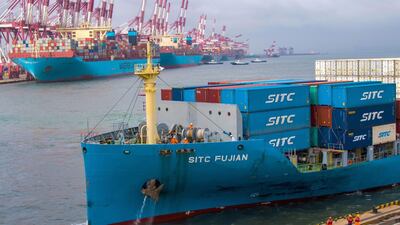Tariffs imposed by the US and China on each other will have minimal impact on the world's two largest economies in the short term, S&P Global Ratings said.
However, the indirect macroeconomic effects are likely to be "many, varied, and capture other trade-dependent economies in their nets like Europe and Canada", S&P economists said on Wednesday in a report on the ensuing trade conflict.
“The more profound risks may lurk elsewhere," they added. "Beyond the macro level, the direct hits on specific sectors, lower-income consumers, and small and midsize enterprises (SMEs) with exposure to tariffs are likely to be sizable.”
A recession is unlikely to hit the US economy, but a meaningful slowdown in US domestic demand from the trade dispute may lead to rate cuts. The Federal Reserve which has been reserved about hiking rates is in a wait-and-see mode, but the chances of an "insurance" rate cut in the US have increased, S&P said.
If the trade war continues to drag on in the long term, the impact on US economy will be more profound, S&P economists said.
"The more profound risks may lurk elsewhere," they added. "Beyond the macro level, the direct hits on specific sectors, lower-income consumers, and small and mid-size enterprises with exposure to tariffs are likely to be sizeable," according to the report.
A recession is unlikely to hit the US economy, but a meaningful slowdown in domestic demand from the trade dispute may lead to rate cuts. The Federal Reserve, which has been conservative, about hiking rates is in a wait-and-see mode, but the chances of an "insurance" rate cut in the US have increased, S&P said.
If the trade tensions continues to drag on in the long term, the effect on US economy will be more profound, S&P economists said.
“The longer-term [negative] consequences for global supply chains, US business sentiment, and consumers’ purchasing power are growing. For now, the increase in tariffs laid out by US President Donald Trump will boost overall US consumer price inflation modestly – even companies such as Walmart and Macy’s are warning that shoppers will almost certainly soon pay higher prices,” S&P said.
The secondary effects of potential financial market volatility, also pose a downside risk to S&P’s growth forecast for the US.
Investors, the rating agency said, have proven to be sensitive to heightened political and economic uncertainty, and the effects on an already slow business investment environment could be significant.
"Add to this potential job losses in certain industries – with many American jobs at risk because of US and Chinese tariffs – and it's clear that the escalation in tensions between the two countries will have notable real-world ramifications," S&P said.
For China the key risk is that the combined effects of investment restrictions, export controls, and tariffs will rewire supply chains and weaken the country’s manufacturing investment, particularly, in the technology sector.
“We don’t see much movement in China’s macro needle coming directly from tariffs,” S&P Ratings said.
“We estimate that China’s value-added exports to the US accounted for a little more than 3 per cent of GDP last year. In turn, we estimate that the direct effects of the latest round of tariff hikes will shave just 0.1 percentage point from China’s GDP in the next 12 months.”
S&P economists see the latest tariff rise as "just a small manifestation of wider trade and investment frictions" and the direct hit from higher US levies is unlikely to jeopardise China's outlook for the next year or so.
The short-term effect on China's economy may be amplified if higher tariffs weaken confidence and reduce spending by companies and households, S&P said.
In Europe, the direct effects of US-China trade friction will be felt in sectors with medium-to-high technological content like transport equipment, motor vehicles, rubber and plastics, chemical products, and pharmaceuticals. The indirect effects in Europe could be more detrimental, S&P said.


